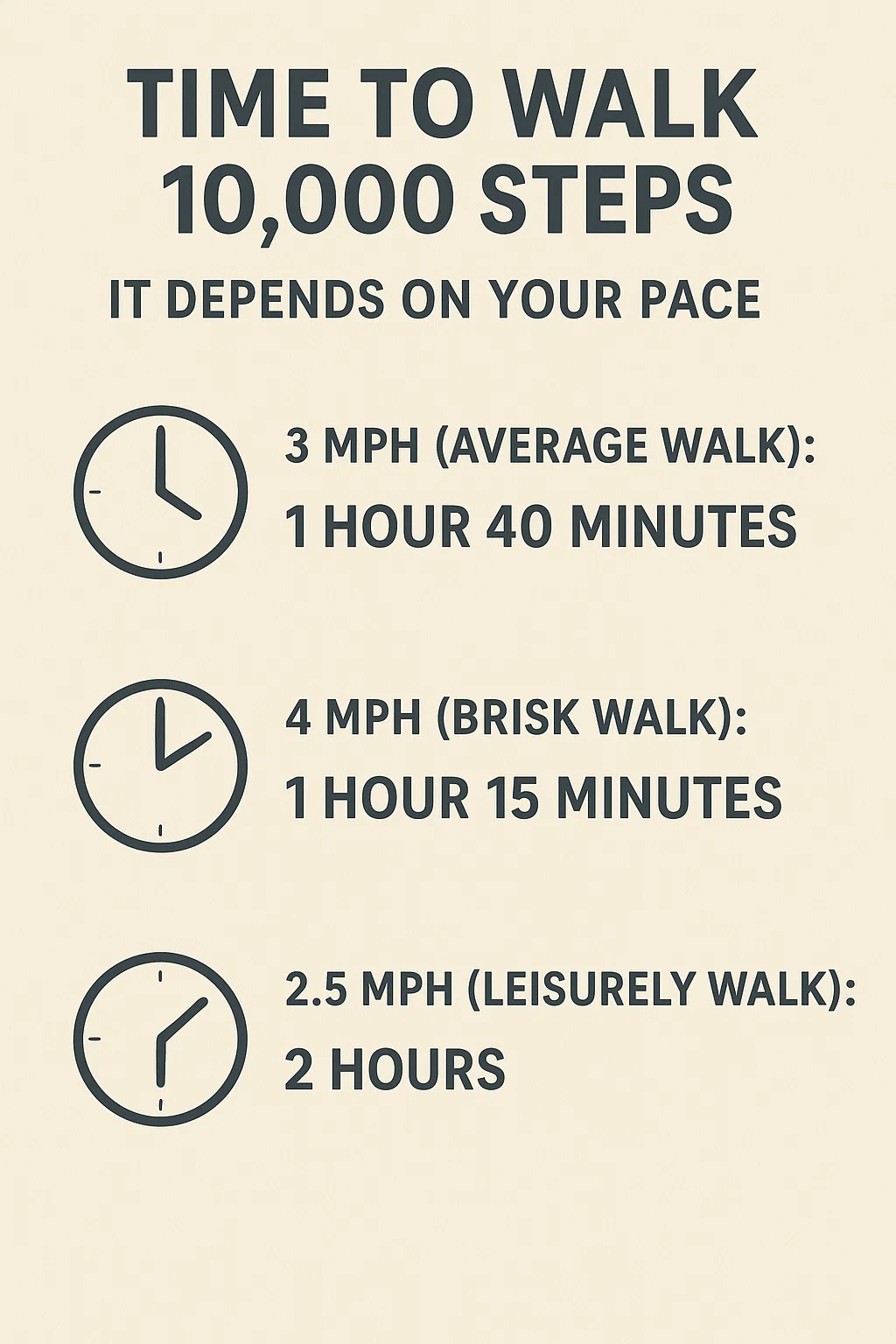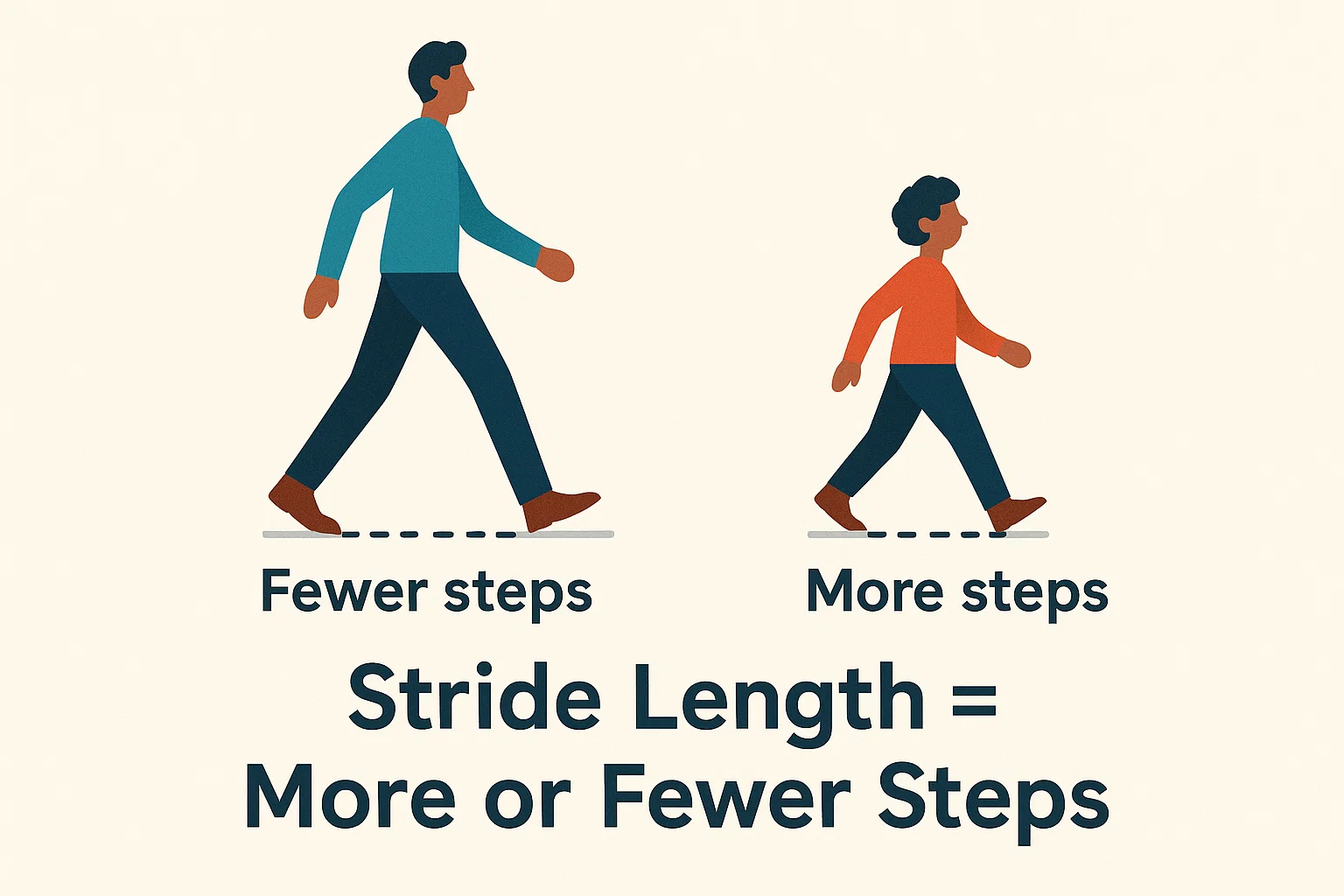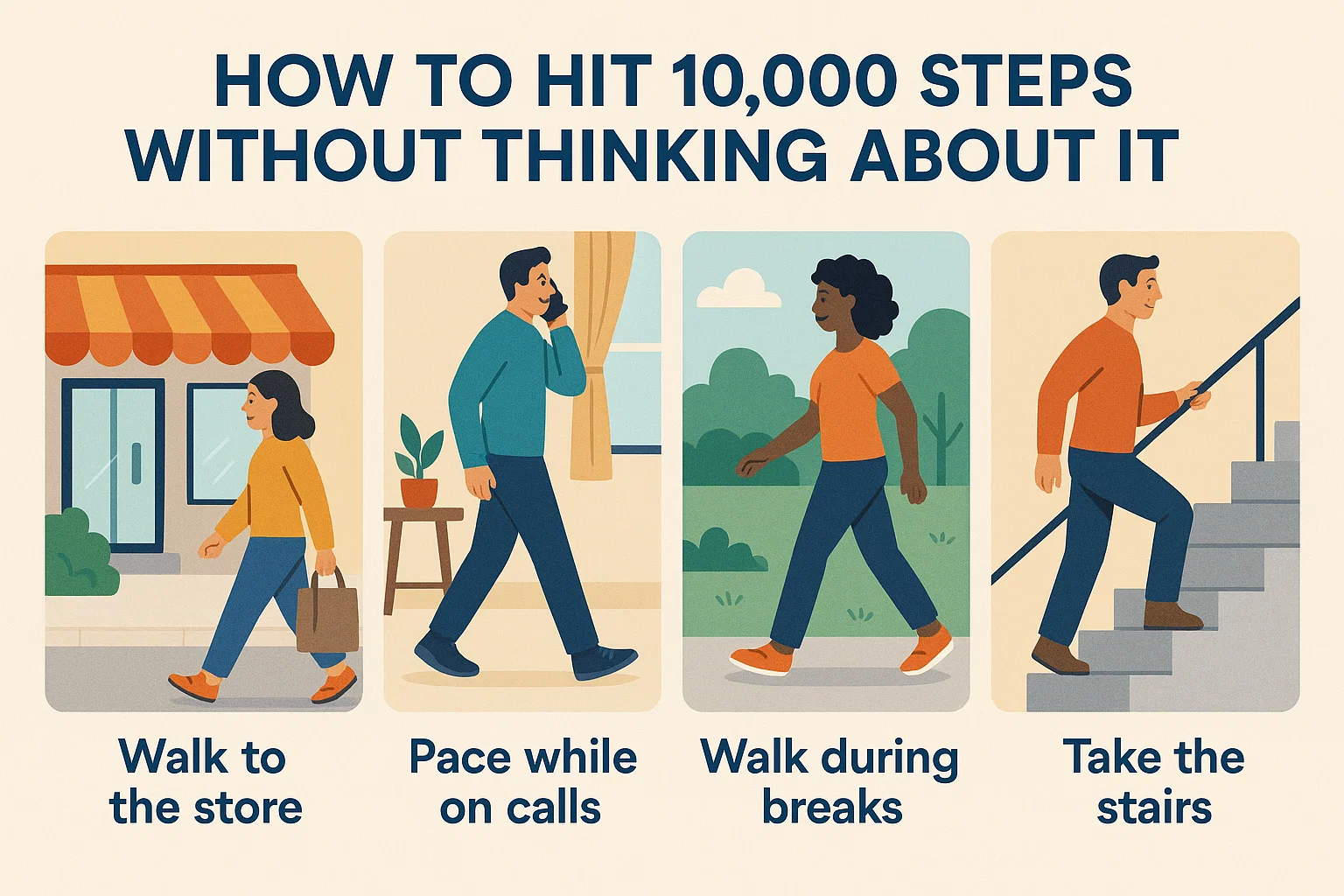Ever finish a day barely scraping 3,000 steps and wonder, how do people manage 10,000 steps every single day?
Trust me, you’re not alone.
I used to look at that 10k number like it was Mount Everest – huge, intimidating, and maybe a bit crazy.
The first time I hit 10,000 steps in one day, I collapsed on the couch and thought, “Wow, do people actually do this every day?!”
It can feel like a full-time job just to get those steps in.
But here’s the thing: once you break it down and find fun, sneaky ways to add steps, 10,000 a day becomes totally achievable.
It’s not just doable; it’s incredibly rewarding – from improving your health and mood to finding a fresh spring in your step (pun intended).
In this guide, I’m gonna show you exactly how far 10,000 steps is, why you should aim for it, and how to walk 10,000 steps without feeling like you’re stuck in a never-ending loop. Let’s lace up and get going!
How Far Is 10,000 Steps?
Alright, the big question: how far are we actually walking here?
Well, in short: about five miles.
For most people, 10,000 steps equals roughly 4 to 5 miles.
Let me break down this even further.
Stride Length Matters
If you’re tall or have a longer stride, each step will cover more ground.
For example, my 6’2″ buddy Joe takes fewer steps than I do to hit the same distance – he’s hitting 5 miles by the time he hits 10k.
On the flip side, my partner is under 5’0” and gets about 4 miles out of 10,000 steps. She once joked that it felt like a marathon for her with those shorter legs!
Well, short people problems right? LOL.
Takeaway: Don’t get hung up on the exact mileage – it changes based on your stride. For the average adult, one step is about 2 to 2.5 feet. Do the math, and 10,000 steps lands you around 5 miles.
Walking vs. Running
Walking 10,000 steps isn’t the same as running 10,000 steps.
When you’re running, your stride naturally gets longer, so you cover more ground.
A runner might hit 5+ miles in 10,000 steps, while a casual walker could hit closer to 4 miles.
And hey, if you throw in some jogging, you might finish that 10k even faster – who doesn’t love a little shortcut?
How Long Does It Take to Walk 10,000 Steps?
Hitting 10,000 steps doesn’t mean you’re walking away your whole day.
Let’s break down the time commitment:
Average Walking Speed
Most folks walk at about 3 miles per hour. That’s roughly 100 steps per minute.
So, if you keep up that pace, you’ll hit 1,000 steps in 10 minutes – meaning 10,000 steps will take you about 1 hour and 40 minutes.
Picking Up the Pace
Walk a little faster, like at a brisk pace or a light jog, and you could be knocking out 130 steps per minute.
That’ll shave your 10,000 steps down to around 80 minutes (or about 1 hour and 20 minutes). You don’t need to break into a sprint – but picking up the pace will definitely get you there quicker!
Leisurely Pace
On the other hand, if you’re strolling along, chatting or soaking in the view, you’ll likely fall below 100 steps per minute, and it could take closer to 2 hours or more to hit 10,000 steps.
But hey, slow days are cool too! Sometimes I like to take my time and add extra steps whenever I can.

Why 10,000 Steps a Day? (It’s Worth It!)
You might be thinking, “10k steps? That sounds like a lot… but is it really worth it?” Trust me, the benefits are huge. Here’s why:
Heart and Health Boost
Walking is like a workout for your heart. Getting 10,000 steps a day helps lower your blood pressure and resting heart rate, making your heart stronger and reducing the risk of heart disease.
Longer Life & Disease Prevention
Walking is linked to lower death rates, especially for people who walk more than 4,000 steps a day. Studies show that 7,000–10,000 steps can reduce your risk of heart disease, certain cancers, and even dementia. More steps = fewer health risks.
Weight Management & Calorie Burn
Trying to shed some pounds? Walking 10,000 steps can help. You’ll burn around 400–500 calories with that many steps. Over time, those calories really add up – and it doesn’t even feel like work!
Mental Health and Mood
Ever notice how a walk clears your mind? That’s because walking releases endorphins – natural mood-boosters that help lower stress and anxiety. Regular walking can even lower the risk of depression, plus it improves creativity and memory. Personally, it’s like hitting the reset button on my day. After a stressful morning, I’ll take a walk to clear my head.
Let me back my claims with some science:
- Study reported that walking about 10,000 steps per day is optimal for reducing the risk of dementia by 50 percent.
- Research in the JAMA Internal Medicine Journal found a link between the possibility of reduced risk of premature death for every 2,000 steps walked in a day.
- This study found that walking often helps reduce knee and joint pain in people with arthritis.
- Study found a direct link between walking and improved mental functions.
How I Personally Hit 10,000 Steps (Without Losing My Mind)
Alright, here’s how I make sure I hit those 10,000 steps each day without turning it into a full-time job:
Track Everything
I use a fitness tracker synced to my phone. I’m not aiming for perfection here—I just want to know where I’m at. Some days, I hit 7,000 steps by noon, and other days, I’m pacing around my kitchen at 9:30 p.m. just to reach 10K. It’s all part of the process.
Break It Up
I’m all about stacking my steps in chunks. Walk to the store. Around the gym. Even pacing while brushing my teeth. Seriously, every little bit counts.
Walk with Purpose
After dinner, my girlfriend and I take a walk together. Sometimes it’s just 10 minutes, other times we go for an hour. It’s a time to connect and rack up those steps—without stressing about it.
Walk During Work
When I’m on calls, I’m moving. I don’t sit down for Zoom meetings unless it’s absolutely necessary. My best ideas come when I’m pacing, so it works for me. Plus, it’s a sneaky way to hit 10K.
Gamify It
Every now and then, I set a challenge for myself: beat my weekly average. One week, I hit 15K steps every day for seven days straight. Felt amazing. Not something I do every week, but it’s a great reminder of what’s possible.
FAQ: All About 10,000 Steps a Day
I know that you have more than one pressing questions about the daily 10,000 steps habit. Let me share my answers to some of the most common concerns.
Q1: How many miles are in 10,000 steps?
On average, 10,000 steps equal about 4 to 5 miles—it depends on your stride length. Taller people may hit closer to 5 miles, while shorter strides might average around 4 miles. It’s a handy benchmark to gauge daily movement.
Q2: Can 10,000 steps help with weight loss?
Absolutely! Walking 10,000 steps daily burns calories, supports cardiovascular health, and encourages consistency. Paired with a balanced diet and healthy lifestyle, it’s a great way to kick-start or maintain a weight-loss journey.
Q3: How long does it take to walk 10,000 steps?
It usually takes 1.5 to 2 hours of walking at a moderate pace (about 3 miles per hour) to reach 10,000 steps. If you’re more brisk or incorporate some hills or inclines, you might hit it faster.
Q4: Does walking 10,000 steps a day count as exercise?
Yes! Walking 10,000 steps a day counts as moderate exercise, especially if you keep a steady pace. It improves cardiovascular health, strengthens bones, and supports overall fitness.
Q5: How can I increase my step count throughout the day?
Look for opportunities like:
Taking the stairs instead of the elevator
Parking farther away from your destination
Taking short walking breaks during the workday
Walking while talking on the phone
Q6: Is 10,000 steps a magic number?
It’s a popular guideline, but not a one-size-fits-all target. Some people thrive with fewer steps; others may aim higher. What matters most is moving consistently and challenging yourself safely.
Q7: Can I break up my 10,000 steps into smaller walks?
Yes! Breaking it into multiple shorter walks—like 15-minute strolls—makes it easier to hit your goal without feeling overwhelmed.
Q8: What’s the best way to track my steps?
Fitness trackers, smartphone apps, or smartwatches are all great options. Pedometers are also simple and affordable. The key is choosing a device that fits your lifestyle.
Q9: How many calories does 10,000 steps burn?
The calories burned vary depending on weight, speed, and terrain, but the average is around 300 to 500 calories for 10,000 steps.
Conclusion
So, how many miles is 10,000 steps? Roughly 5 miles, depending on your stride length.
The real challenge is ensuring you hit that number consistently, but it’s entirely achievable with some small changes to your daily habits.
Whether walking for health, fitness, or just to get outside and move, aiming for 10,000 steps a day is a fantastic goal.
Got questions or want to share your step count journey? Drop a comment below—I’d love to hear how you’re working walking into your daily routine!



I disagree with the idea that 10,000 steps consistently equates to 4-5 miles. My stride is on the shorter side, so I barely hit 4 miles on 10,000 steps. Stride length makes a huge difference!”
I have to disagree a little. For shorter people like me, 10,000 steps is closer to 3.5-4 miles. Stride length plays such a big role in determining the actual distance covered.
Thank you for clarifying how many miles 10,000 steps covers! It’s nice to have a general range of 4-5 miles, though it’s definitely true that stride length can cause variations.
I’ve always heard that 10,000 steps equals around 5 miles, but it’s great to see the range of 4-5 miles explained here. This helps me better understand how active I am during the day.”
This was really helpful! I always wondered how far 10,000 steps actually was. Knowing it’s around 4-5 miles gives me a much better sense of my daily activity.”
Great explanation, but I think the average distance covered in 10,000 steps varies more than your article suggests. For taller individuals like myself, 10,000 steps is often closer to 6 miles
This article was really informative! I’ve always wondered if I was covering enough distance by aiming for 10,000 steps, and now I know it’s roughly 4-5 miles. Thanks for the clear explanation!”
This guide is super helpful! I had no idea how variable step lengths could be. I’ll definitely use the calibration tips to get a more accurate measure of my daily steps. Thanks for breaking it down!